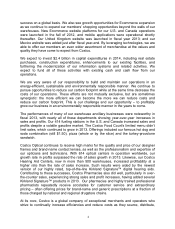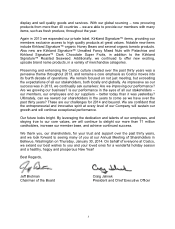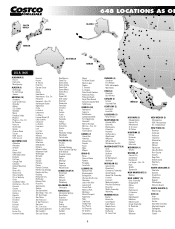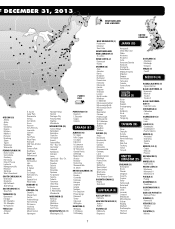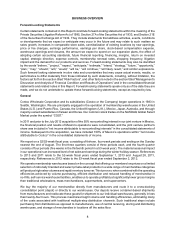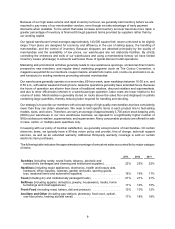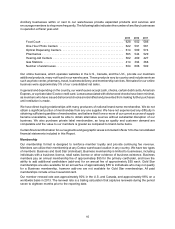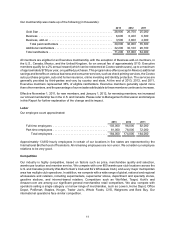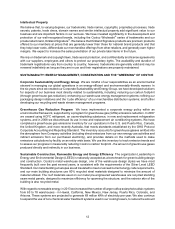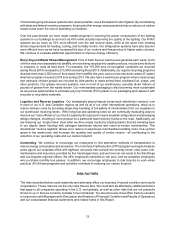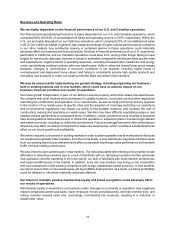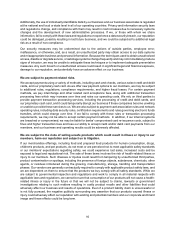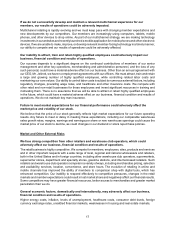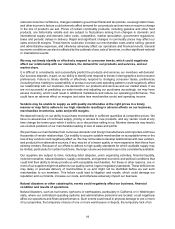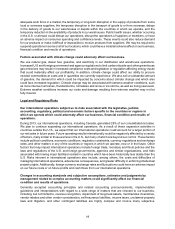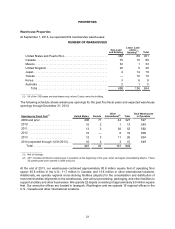Costco 2013 Annual Report Download - page 16
Download and view the complete annual report
Please find page 16 of the 2013 Costco annual report below. You can navigate through the pages in the report by either clicking on the pages listed below, or by using the keyword search tool below to find specific information within the annual report.
14
Business and Operating Risks
We are highly dependent on the financial performance of our U.S. and Canadian operations.
Our financial and operational performance is highly dependent on our U.S. and Canadian operations, which
comprised 88% and 84% of consolidated net sales and operating income in 2013, respectively. Within the
U.S., we are highly dependent on our California operations, which comprised 23% of consolidated net sales
in 2013. Our California market, in general, has a larger percentage of higher volume warehouses as compared
to our other markets. Any substantial slowing or sustained decline in these operations could materially
adversely affect our business and financial results. Declines in financial performance of our U.S. operations,
particularly in California, and our Canadian operations could arise from, among other things: failing to meet
targets for warehouse openings; declines in actual or estimated comparable warehouse sales growth rates
and expectations; negative trends in operating expenses, including increased labor, healthcare and energy
costs; cannibalizing existing locations with new warehouses; shifts in sales mix toward lower gross margin
products; changes or uncertainties in economic conditions in our markets, including higher levels of
unemployment and depressed home values; and failing to consistently provide high quality products and
innovative new products to retain our existing member base and attract new members.
We may be unsuccessful implementing our growth strategy, including expanding our business,
both in existing markets and in new markets, which could have an adverse impact on our
business, financial condition and results of operations.
Our future growth is dependent, in part, on our ability to acquire property, and build or lease new warehouses.
We compete with other retailers and businesses for suitable locations. Local land use and other regulations
restricting the construction and operation of our warehouses, as well as local community actions opposed
to the location of our warehouses at specific sites and the adoption of local laws restricting our operations
and environmental regulations may impact our ability to find suitable locations, and increase the cost of
constructing, leasing and operating our warehouses. We also may have difficulty negotiating leases or real
estate purchase agreements on acceptable terms. In addition, certain jurisdictions have enacted or proposed
laws and regulations that would prevent or restrict the operation or expansion plans of certain large retailers
and warehouse clubs, including us, within their jurisdictions. Failure to manage these and other similar factors
effectively may affect our ability to timely build or lease new warehouses, which could have a material adverse
effect on our future growth and profitability.
We seek to expand our business in existing markets in order to attain a greater overall market share. Because
our warehouses typically draw members from their local areas, a new warehouse may draw members away
from our existing warehouses and adversely affect comparable warehouse sales performance and member
traffic at those existing warehouses.
We also intend to open warehouses in new markets. The risks associated with entering a new market include
difficulties in attracting members due to a lack of familiarity with us, attracting members of other wholesale
club operators currently operating in the new market, our lack of familiarity with local member preferences,
and seasonal differences in the market. In addition, entry into new markets may bring us into competition
with new competitors or with existing competitors with a large, established market presence. In new markets,
we cannot ensure that our new warehouses will be profitably deployed and, as a result, our future profitability
could be delayed or otherwise materially adversely affected.
Our failure to maintain positive membership loyalty and brand recognition could adversely affect
our results of operations.
Membership loyalty is essential to our business model. Damage to our brands or reputation may negatively
impact comparable warehouse sales, lower employee morale and productivity, diminish member trust, and
reduce member renewal rates and, accordingly, membership fee revenues, resulting in a reduction in
shareholder value.


